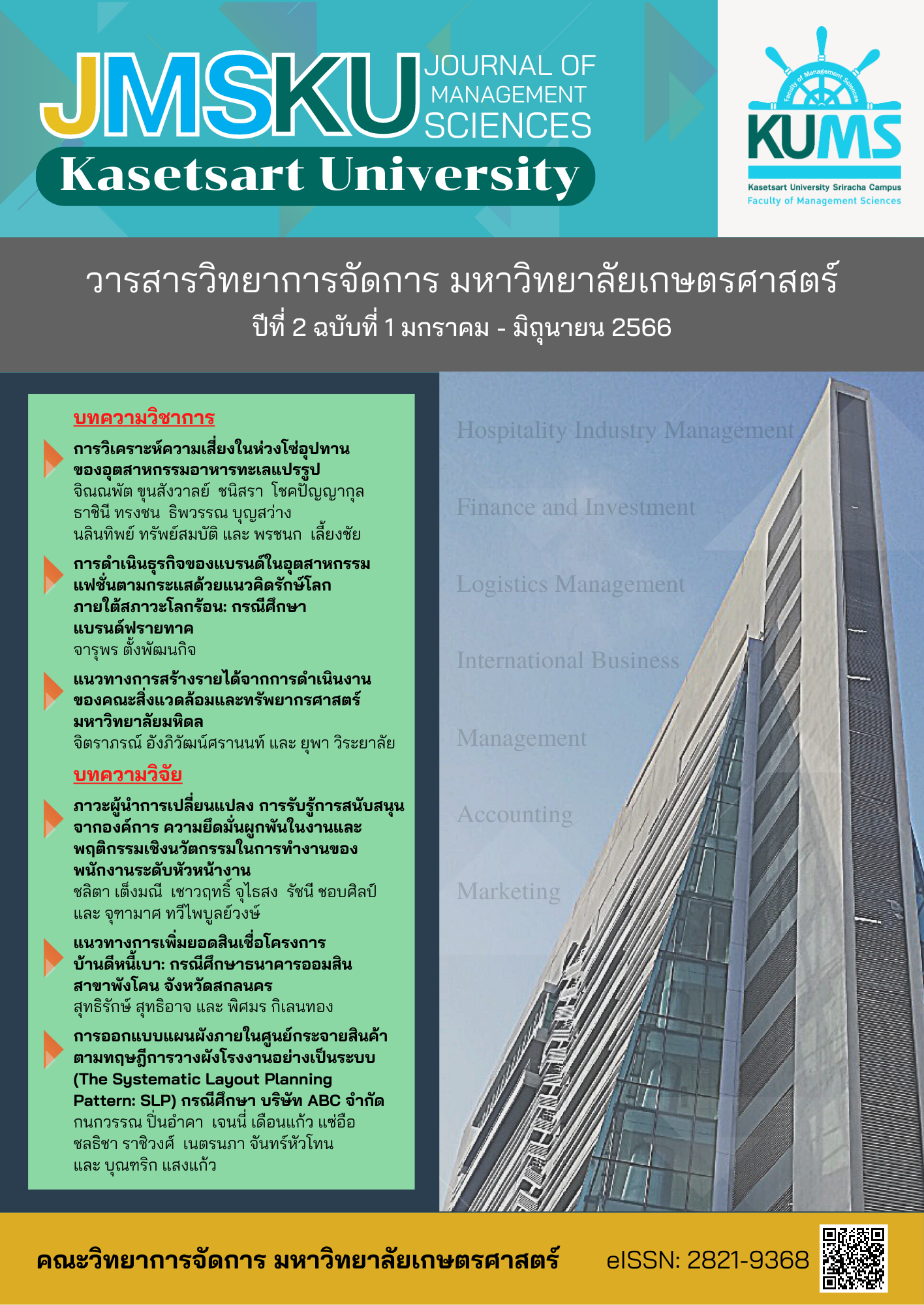แนวทางการเพิ่มยอดสินเชื่อโครงการบ้านดีหนี้เบา: กรณีศึกษาธนาคารออมสิน สาขาพังโคน จังหวัดสกลนคร
##plugins.themes.bootstrap3.article.main##
บทคัดย่อ
การศึกษานี้ใช้วิธีวิจัยแบบผสม โดยมีวัตถุประสงค์เพื่อ 1) ศึกษาปัจจัยด้านประชากรศาสตร์ ปัจจัยด้านพฤติกรรมศาสตร์ ปัจจัยส่วนประสมทางการตลาด และปัจจัยแรงจูงใจที่มีผลต่อการเลือกใช้บริการสินเชื่อโครงการบ้านดีหนี้เบา 2) วิเคราะห์หาสาเหตุและปัญหาที่ส่งผลกระทบต่อการเพิ่มยอดสินเชื่อโครงการบ้านดีหนี้เบา 3) เพื่อวางแผนกลยุทธ์ทางการตลาดโดยมุ่งเน้นการเพิ่มยอดสินเชื่อโครงการบ้านดีหนี้เบา ให้บรรลุตามเป้าหมาย โดยใช้แบบสอบถามในการเก็บข้อมูลจากกลุ่มตัวอย่างลูกค้าสินเชื่อที่มีที่อยู่อาศัยเป็นหลักประกัน กับธนาคารออมสินสาขาพังโคน จำนวน 279 ราย และเก็บข้อมูลจากการสัมภาษณ์บุคลากรด้านสินเชื่อของธนาคารออมสินสาขาพังโคน จำนวน 2 คน และกลุ่มลูกค้าที่มีหลักประกันกับธนาคารออมสินสาขาพังโคน จำนวน 5 คน รวม 7 คน วิเคราะห์สถิติเชิงพรรณนาโดยใช้ ค่าร้อยละ ค่าเฉลี่ย ส่วนเบี่ยงเบนมาตรฐาน ค่าความถี่ และวิเคราะห์สถิติเชิงอนุมาน ใช้การทดสอบค่าที และการวิเคราะห์ความแปรปรวนทางเดียว (One – Way ANOVA) ผลการศึกษาพบว่า 1) ปัจจัยด้านประชากรศาสตร์ที่แตกต่างกัน มีผลต่อการตัดสินใจที่จะทำให้เลือกใช้บริการสินเชื่อโครงการบ้านดีหนี้เบากับธนาคารออมสิน สาขาพังโคนแตกต่างกัน อย่างมีนัยสำคัญทางสถิติที่ระดับ 0.05 ปัจจัยด้านพฤติกรรมศาสตร์ที่ส่งผลต่อการเลือกใช้บริการสินเชื่อโครงการบ้านดีหนี้เบามากที่สุดคือ การติดต่อทำธุรกรรมกับธนาคารออมสินด้านเงินฝาก เช่น ฝากเงิน ถอนเงิน สลากออมสิน ปัจจัยส่วนประสมทางการตลาด ด้านผลิตภัณฑ์และบริการ และด้านกระบวนการให้บริการ ส่งผลต่อการเลือกใช้บริการสินเชื่อโครงการบ้านดีหนี้เบามากที่สุด ปัจจัยด้านแรงจูงใจที่ส่งผลต่อการเลือกใช้บริการสินเชื่อโครงการบ้านดีหนี้เบามากที่สุดคือ วงเงินกู้สูงสุดที่ธนาคารอนุมัติ 2) สาเหตุของปัญหาที่ส่งผลกระทบต่อการเพิ่มยอดสินเชื่อโครงการบ้านดีหนี้เบาประกอบด้วย (1) ปัจจัยทางประชากรศาสตร์ พบว่า ลูกค้าส่วนใหญ่ขาดความเข้าใจในการกรอกเอกสารต่าง ๆ และการขอสินเชื่อ (2) ปัจจัยภายในของธนาคาร พบว่า กระบวนการให้บริการด้านเอกสารประกอบการกู้ขาดประสิทธิภาพ พนักงานมีไม่เพียงพอต่อให้บริการลูกค้าที่มาใช้บริการจำนวนมาก (3) ปัจจัยส่วนประสมทางการตลาด พบว่า ลูกค้าให้ความสำคัญกับเงื่อนไขการรวมหนี้ของโครงการสินเชื่อบ้านดีหนี้เบา ในขณะที่รูปแบบการนำเสนอของธนาคารขาดประสิทธิภาพ ขาดการประชาสัมพันธ์ (4) ปัจจัยสภาพแวดล้อมภายนอก พบว่า มีธนาคารคู่แข่งอยู่ในพื้นที่ มีบริการสินเชื่อที่มีลักษณะใกล้เคียงและสามารถทดแทนผลิตภัณฑ์สินเชื่อของธนาคารออมสินได้ 3) การวางแผนกลยุทธ์ทางการตลาดประกอบด้วย Marketing strategy และ People Management strategy ซึ่งทั้ง 2 แนวทางนี้ คาดว่าจะสามารถเพิ่มยอดสินเชื่อโครงการบ้านดีหนี้เบาให้กับธนาคารออมสินสาขาพังโคน จังหวัดสกลนครได้
